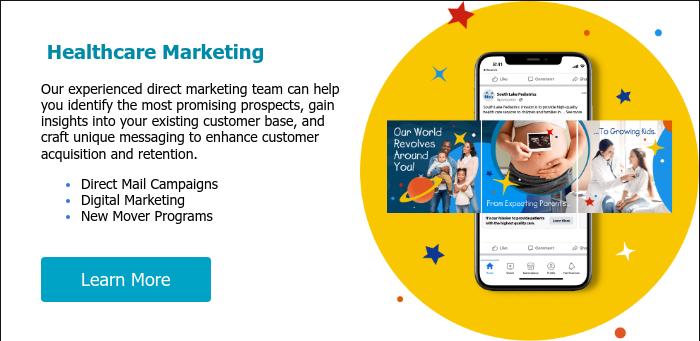Direct Response Marketing Healthcare: How It Boosts Patient Engagement
Streamworks Blog
.jpg?width=950&height=633&name=modern-desk-laptop-notebook-plant_%20(1).jpg)
Changing trends in healthcare marketing, such as the rise of digital strategies and evolving patient expectations, are driving the adoption of direct response marketing.
What Is Direct Response Marketing in Healthcare?
Direct response marketing is all about prompting action. Rather than simply creating awareness or building long-term brand equity, it focuses on getting a specific and measurable response from the audience.
In healthcare, that might mean:
-
Joining a new clinic
-
Downloading a wellness guide
-
Scheduling an appointment
-
Subscribing to email updates or newsletters
-
Schedule appointments online
-
Responding to appointment reminders
These actions are typically driven through targeted campaigns using direct mail marketing, digital marketing, mailing lists, and other forms such as brochures or web links, as well as digital ads, email blasts, landing pages, and social media promotions with a clear call-to-action (CTA). Combining these marketing channels helps healthcare providers attract new patients and introduce new services to the community. It is essential to stay HIPAA compliant when using direct mail marketing and digital marketing in healthcare to protect patient information.
Why It's Gaining Traction in Healthcare
Patients Are Acting More Like Consumers
Healthcare decisions are no longer confined to the doctor's office. Patients are researching providers, comparing services, and reading reviews from the comfort of their home. Direct response marketing provides convenience, transparency, and instant options for the patient to act upon.
It’s Measurable and ROI-Focused
Unlike traditional branding campaigns, direct response efforts are trackable. Marketers can see which ads, channels, or keywords drive conversions and optimize in real-time. For healthcare organizations with tight budgets and increasing pressure to prove return on investment, this level of accountability is invaluable.
Healthcare organizations use ROI analysis and financial metrics such as net profit, cost savings, and revenue growth to measure the effectiveness of their marketing efforts. Focusing on long term ROI and long term success helps organizations make informed decisions and manage costs more effectively. Tracking financial benefits and improved productivity are key outcomes of continuous improvement in direct response marketing.
It Supports Strategic Service Line Growth
Hospitals and clinics often need to promote specific healthcare services and healthcare practices, such as pediatrics, orthopedics, maternity, or urgent care, based on seasonal trends or capacity. Focusing on critical roles within these service lines ensures effective delivery and promotion. Predictive analytics can help identify areas for growth and optimize future campaigns by analyzing performance data and forecasting trends. Direct response tactics allow for targeted outreach to the right demographics, in the right locations, with clear messaging tied to a defined outcome.
It Strengthens Patient Engagement
By encouraging actions like resource downloads or email subscriptions, direct response marketing helps providers build long-term relationships with patients. These micro-conversions often lead to stronger loyalty, more referrals, and better health outcomes over time. Increased engagement not only contributes to improved patient outcomes and more satisfied patients, but can also enhance employee satisfaction, as engaged and loyal patients create a more positive environment for healthcare staff.
Creating Engaging Content for Direct Response
Creating engaging content is at the heart of successful direct response marketing for healthcare organizations. In today’s competitive healthcare industry, it’s not enough to simply reach your target audience—you need to capture their attention and inspire them to take action. Whether you’re connecting with potential patients, healthcare professionals, or other healthcare stakeholders, your content should be tailored to address their unique needs and concerns.
Healthcare providers can leverage a mix of digital channels—such as social media platforms, email marketing, and digital ads—alongside traditional physical mail to deliver their message. Each channel offers an opportunity to share valuable content, from wellness tips and updates on new services to answers for common concerns about medical procedures and health outcomes. By consistently providing information that matters to healthcare consumers, organizations can build trust and establish themselves as reliable sources of healthcare information.
Creating Engaging Content for Direct Response
Creating engaging content is at the heart of successful direct response marketing for healthcare organizations. In today’s competitive healthcare industry, it’s essential for healthcare providers to develop a marketing strategy that truly connects with their target audience—whether that’s potential patients, healthcare professionals, or key healthcare stakeholders. The right content, delivered through digital channels like social media platforms, email marketing, and digital ads, or through traditional physical mail, can make a significant impact on patient engagement and overall marketing success.
To stand out, healthcare organizations should focus on content that addresses the real questions and concerns of healthcare consumers. This means providing clear information about medical procedures, sharing wellness tips, and offering insights into health outcomes that matter most to your audience. By delivering valuable, personalized communication, healthcare providers can build trust and establish themselves as reliable sources of healthcare information.
Wrapping It All Together
The future of healthcare marketing isn’t just about being seen, it’s about driving meaningful action. As patients expect more control and immediacy in their healthcare choices, direct response marketing offers a strategic, measurable, and patient-centered way forward.
Healthcare leaders and healthcare organizations are increasingly leveraging workforce solutions and healthcare workforce solutions to improve marketing outcomes, boost operational efficiency, and enhance patient engagement. Many organizations are adopting digital platforms and video content to reach more patients, build trust, and ensure the protection of patient information and data privacy. It is also essential to comply with international regulations when conducting direct mail marketing and using other marketing channels to maintain legal and ethical standards. By integrating multiple marketing strategies, healthcare providers can maximize their reach and engagement, ultimately driving better health outcomes.
This approach allows healthcare providers to create personalized, targeted campaigns that resonate with individuals on a deeper level, addressing their specific needs, concerns, and preferences. The ability to track and measure responses in real-time ensures that marketing efforts are not only reaching the right audience but also capturing exact results.




